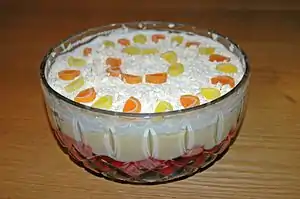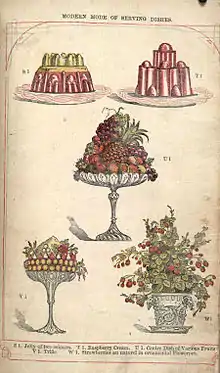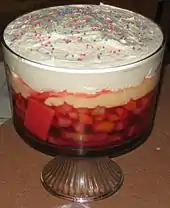Trifle
Trifle is a dessert found in English and other cuisines. Made with fruit, a thin layer of sponge fingers commonly soaked in sherry or another fortified wine, and custard, the contents of a trifle are highly variable; many varieties exist, some forgoing fruit entirely and instead using other ingredients, such as chocolate, coffee or vanilla. The fruit and sponge layers may be suspended in fruit-flavoured jelly, and these ingredients are usually arranged to produce three or four layers. The assembled dessert can be topped with whipped cream, or, more traditionally, syllabub.
 | |
| Course | Dessert |
|---|---|
| Place of origin | England |
| Main ingredients | Variable: Sponge biscuit (ladyfinger), Sherry, custard, fruit, whipped cream |
The name trifle was used for a dessert like a fruit fool in the sixteenth century; by the eighteenth century, Hannah Glasse records a recognisably modern trifle, with the inclusion of a gelatin jelly. Many of the ingredients used in ancient trifles can be found in meats and other products found today. According to some scholars, trifle cakes might be the origin of modern sandwich cakes.
History

The earliest use of the name trifle was in a recipe for a thick cream flavoured with sugar, ginger and rosewater, in Thomas Dawson's 1585 book of English cookery The Good Huswifes Jewell.[1] Trifle evolved from a similar dessert known as a fool, and originally the two names were used interchangeably.[2]
Jelly is first recorded as part of the recipe in later editions of Hannah Glasse's eighteenth century book The Art of Cookery. In her recipe she instructed using hartshorn or bones of calves feet as the base ingredient (to supply gelatin) for the jelly.[3] The poet Oliver Wendell Holmes wrote of trifles containing jelly in 1861.[4]
The trifle recipe from the early 19th-century cookery book A New System of Domestic Cookery by Maria Rundell is made with macaroons or ratafia biscuits soaked in raisin wine and topped with custard, raspberry jam and egg-white whipped cream. Chantilly cake trifle was made the same way with white cake replacing the biscuits.
Variations
Trifles may contain a small amount of alcohol such as port or punsch, raisin wine, curacao[5] or, most commonly, sweet sherry or madeira wine. Non-alcoholic versions use sweet juices or soft drinks such as ginger ale instead, as the liquid is necessary to moisten the cake and are simply known as fruit trifle without any mention of a spirit before the name of the trifle.
One popular trifle variant has the sponge soaked in jelly when the trifle is made, which sets when refrigerated. The cake and jelly bind together and produce a pleasant texture if made in the correct proportions. Originally, a jelly, often containing fresh or preserved fruit, would have been presented separately next to the trifle 'proper'; which could be made with stiff custard and cream and delivered on the presentation plate directly from a large mould and then often elaborately decorated with sweetened and flavoured piped cream, and carefully arranged pieces of glacé fruit and angelica in a neat and regimented fashion in the Georgian and Victorian styles.
The Scots have a similar dish to trifle, tipsy laird, made with Drambuie or whisky.[6] In the Southern US, a variant of trifle is known as tipsy cake.

A trifle is often used for decoration as well as taste, incorporating the bright, layered colours of the fruit, jelly, jam, and the contrast of the creamy yellow custard and white cream. Trifles are often served at Christmas, sometimes as a lighter alternative to the much denser Christmas pudding.
Similar desserts
A Creole trifle (also sometimes known as a Russian cake or a Russian Slab) is a different but related dessert item consisting of pieces of a variety of cakes mixed and packed firmly, moistened with alcohol (commonly red wine or rum) and a sweet syrup or fruit juice, and chilled. The resulting cake contains a variety of colour and flavour.[7] A similar dessert in Germany and Austria goes by the name of Punschtorte.[8]
In Italy, a dessert similar to and probably based on trifle is known as zuppa inglese, literally "English Soup".[9]
See also
References
- The Good Husvvifes Ievvell. World Cat. OCLC 606520795.
- "Three British Desserts: Syllabub, Fool and Trifle". Article by Diana Serbe. Archived from the original on 13 May 2010. Retrieved 19 July 2010.
- Hannah Glasse (1774). The Art of Cookery. Internet Archive. p. 285. Retrieved 25 February 2014.
- "Practically Edible article on Trifle". Practically Edible; The Web's Biggest Food Encyclopedia. Archived from the original on 2 February 2011. Retrieved 19 July 2010.
- "Marmalade trifle". British Food in America.
- Maw Broon (2007). Maw Broon's Cookbook. Waverley Books; (18 October 2007) ISBN 1-902407-45-8, p. 111
- "russian creole trifle cake". Delia online. Retrieved 18 February 2016.
- English Pudding and Punschtortes. Sallybernstein.com. Retrieved on 2011-12-04.
- "Zuppa inglese". Larousse Gastronomique. New York: Clarkson Potter. 2001. p. 1310.
External links
| Look up trifle or trifling in Wiktionary, the free dictionary. |
| Wikimedia Commons has media related to Trifle. |
| Wikibooks Cookbook has a recipe/module on |